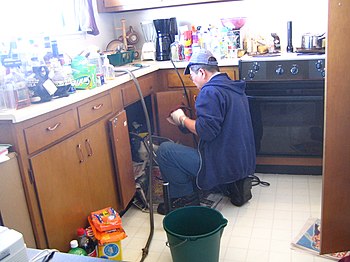Do It Yourself, Safely: Plumbing
MySafetySign applauds the do-it-yourself spirit of home renovations, but there are often the same hazards in your weekend fixer-upper as there are on professional construction jobs. We want to make sure your project ends with a satisfied feeling of accomplishment, not a visit to the emergency room. Follow along as we cover the basics of home DIY in our series: Do It Yourself, Safely.
Some DIY projects are just inherently more dangerous than others. For instance, there’s a certain fear factor that comes with any electrical work you might need doing. The risk of dealing with live wires is enough to dissuade many homeowners to wave the white flag and call in a pro. But not so much with plumbing. From upgrading faucets and clearing clogged drains to running new water lines, many DIYers are more than willing to get their hands dirty, and wet. A socket wrench, a couple of wet rags, a bucket? How hard can it be?
But before you jump into a plumbing project, here are just a few reasons to test the water — and evaluate your skills — before you leap.
What can go wrong?
Fire: You’re using a torch to solder a copper pipe, working very close to combustible elements like wood, drywall and insulation. And, since you’re working with plumbing, the water is turned off. See the bad direction this is headed? A little molten solder can quickly cause a large fire, but also can smolder for hours and pick up later, when your focus is elsewhere.
Chemical burns: Drain-cleaning products work for a reason: They’re typically strong, volatile chemicals that can cause chemical burns. If, in your desperation to drain the tub or sink, you mix an acid and an alkali cleaner, it can even cause an explosion.
Polluted drinking water: A faulty connection on a water supply line could allow polluted water to back-flow into your drinking water. In addition, using incorrect piping or solder to replace lines can introduce impurities, and even lead, into your water.
Scalding: If you leave the water supply turned on during a plumbing project, a flooded bathroom or kitchen is just one of the potential risks. Working with pipes that could contain steam or hot water presents the potential for scalding – especially if you are working in a snug space.
Sewer gas: If you’re dealing with a waste line, you could open the door to sewer gas. In addition to its noxious smell, this gas also can be toxic – causing upper respiratory irritation to nausea and even death at high concentrations – and highly explosive, thanks to methane and hydrogen sulfide.Eye injury: Because plumbing repairs and replacements commonly require working underneath a pipe, eye damage from debris and chemicals is a frequent problem.
Best Practices
- Before beginning work, turn off water at the main shut-off valve.
- Wear safety glasses with side shields to protect eyes against objects as well as hot water.
- Make sure that pipe for indoor water use is approved for potable water and contains no more than 0.25 percent lead by weighted average, as rated by the National Sanitation Foundation. These will be marked “NSF61” (for potable water) and “NSF/ANSI 61-G,” “NSF pw-G,” “NSF/ANSI 372” or “NSF® 372” (for low lead content).
- You also must use lead-free solder designed for lines carrying drinking water; it’s required by the Safe Water Drinking Act.
- Temporarily cap waste lines to prevent gas from leaking into the house. This can be done simply with a rag and inverted bucket, or a sealable cap designed for the purpose.
- When soldering, use fire-resistant cloth or a large piece of sheet metal to protect surrounding material. Keep a spray bottle and fire extinguisher on hand, and wear heavy gloves and a long-sleeve shirt to protect from dripping solder.
- Don’t mix chemicals when attempting to clear a clogged drain, and don’t look down the drain after pouring a chemical. The solution often boils up and gives off toxic fumes. Before using harsh chemicals, try this homemade approach first: Dump half a cup of baking soda down the drain, followed by half a cup of white vinegar. Cover the mixture and let it sit for several minutes, then pour boiling water down the drain.
Further Resources
- https://www.crystalblueplumbing.com/plumbing-diy-safety/
- https://www.thisoldhouse.com/toh/how-to/overview/0,,20076102,00.html
- https://www.dhs.wisconsin.gov/eh/air/fs/sewergas.htm
- http://www.nsf.org/consumer-resources/water-quality/faucets-plumbing/plumbing-product-markings
Category: DIY Safety












